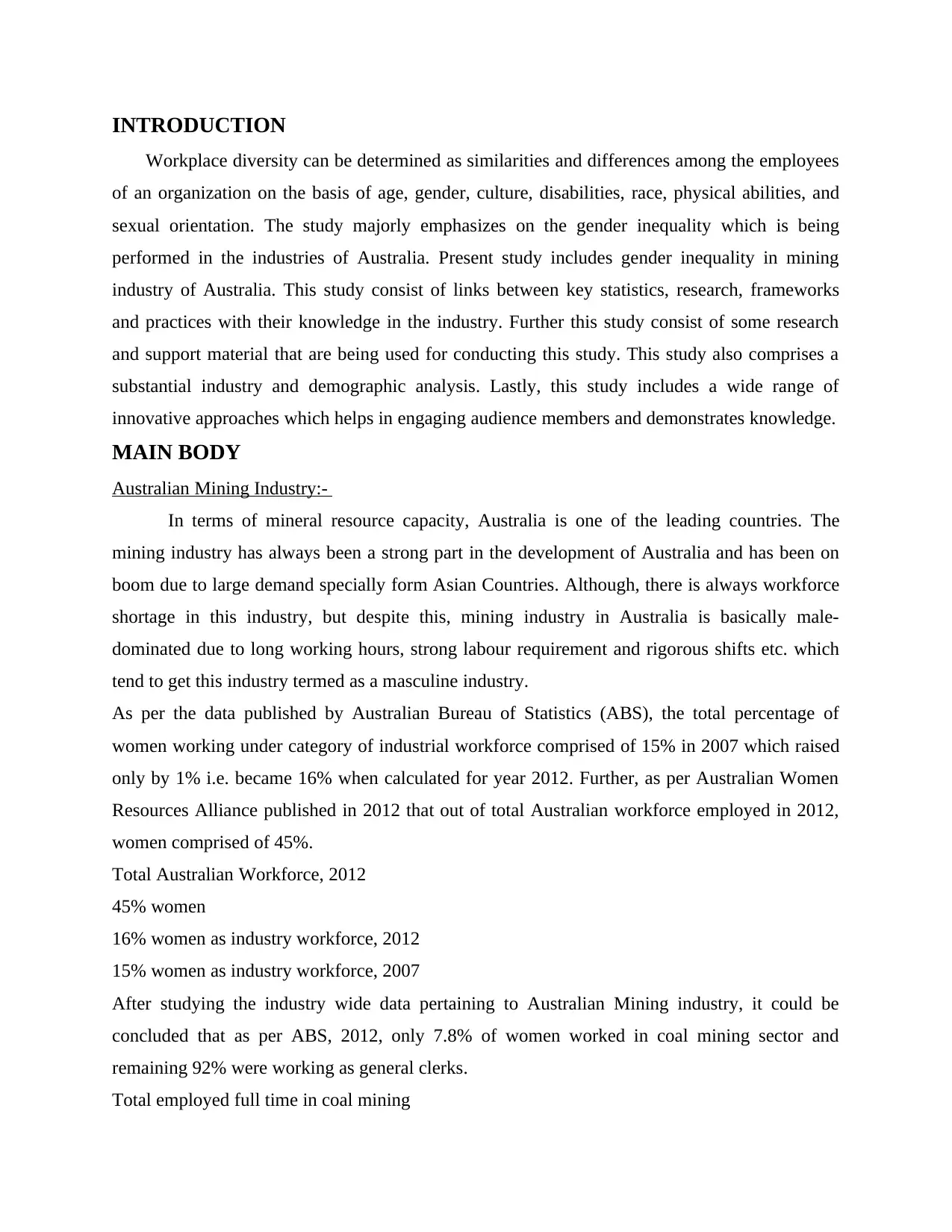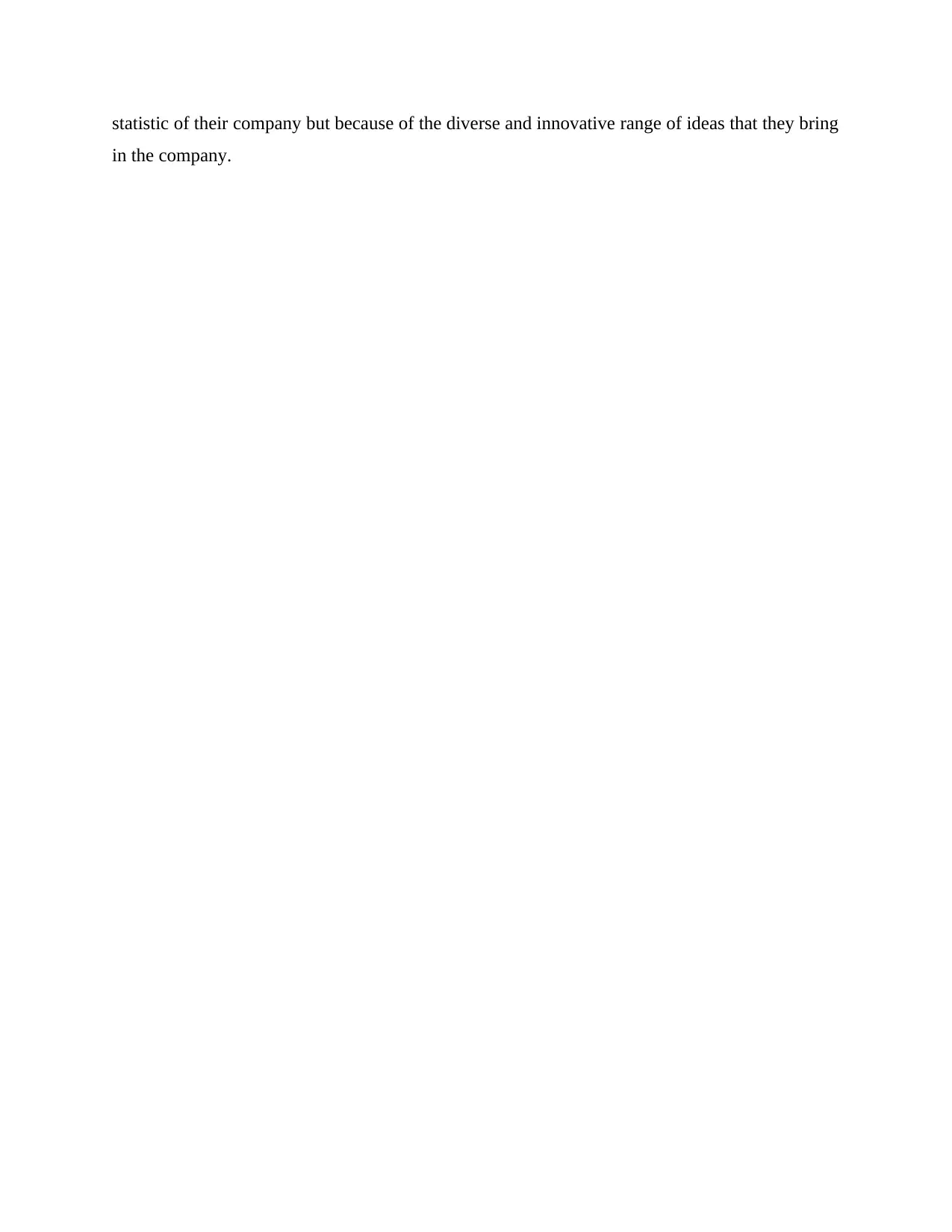Australian Mining Industry Assignment PDF
VerifiedAdded on 2021/02/21
|5
|853
|17
AI Summary
Contribute Materials
Your contribution can guide someone’s learning journey. Share your
documents today.

Secure Best Marks with AI Grader
Need help grading? Try our AI Grader for instant feedback on your assignments.

Table of Contents
INTRODUCTION...........................................................................................................................3
MAIN BODY..................................................................................................................................3
CONCLUSION................................................................................................................................7
REFERENCES................................................................................................................................8
INTRODUCTION...........................................................................................................................3
MAIN BODY..................................................................................................................................3
CONCLUSION................................................................................................................................7
REFERENCES................................................................................................................................8

INTRODUCTION
Workplace diversity can be determined as similarities and differences among the employees
of an organization on the basis of age, gender, culture, disabilities, race, physical abilities, and
sexual orientation. The study majorly emphasizes on the gender inequality which is being
performed in the industries of Australia. Present study includes gender inequality in mining
industry of Australia. This study consist of links between key statistics, research, frameworks
and practices with their knowledge in the industry. Further this study consist of some research
and support material that are being used for conducting this study. This study also comprises a
substantial industry and demographic analysis. Lastly, this study includes a wide range of
innovative approaches which helps in engaging audience members and demonstrates knowledge.
MAIN BODY
Australian Mining Industry:-
In terms of mineral resource capacity, Australia is one of the leading countries. The
mining industry has always been a strong part in the development of Australia and has been on
boom due to large demand specially form Asian Countries. Although, there is always workforce
shortage in this industry, but despite this, mining industry in Australia is basically male-
dominated due to long working hours, strong labour requirement and rigorous shifts etc. which
tend to get this industry termed as a masculine industry.
As per the data published by Australian Bureau of Statistics (ABS), the total percentage of
women working under category of industrial workforce comprised of 15% in 2007 which raised
only by 1% i.e. became 16% when calculated for year 2012. Further, as per Australian Women
Resources Alliance published in 2012 that out of total Australian workforce employed in 2012,
women comprised of 45%.
Total Australian Workforce, 2012
45% women
16% women as industry workforce, 2012
15% women as industry workforce, 2007
After studying the industry wide data pertaining to Australian Mining industry, it could be
concluded that as per ABS, 2012, only 7.8% of women worked in coal mining sector and
remaining 92% were working as general clerks.
Total employed full time in coal mining
Workplace diversity can be determined as similarities and differences among the employees
of an organization on the basis of age, gender, culture, disabilities, race, physical abilities, and
sexual orientation. The study majorly emphasizes on the gender inequality which is being
performed in the industries of Australia. Present study includes gender inequality in mining
industry of Australia. This study consist of links between key statistics, research, frameworks
and practices with their knowledge in the industry. Further this study consist of some research
and support material that are being used for conducting this study. This study also comprises a
substantial industry and demographic analysis. Lastly, this study includes a wide range of
innovative approaches which helps in engaging audience members and demonstrates knowledge.
MAIN BODY
Australian Mining Industry:-
In terms of mineral resource capacity, Australia is one of the leading countries. The
mining industry has always been a strong part in the development of Australia and has been on
boom due to large demand specially form Asian Countries. Although, there is always workforce
shortage in this industry, but despite this, mining industry in Australia is basically male-
dominated due to long working hours, strong labour requirement and rigorous shifts etc. which
tend to get this industry termed as a masculine industry.
As per the data published by Australian Bureau of Statistics (ABS), the total percentage of
women working under category of industrial workforce comprised of 15% in 2007 which raised
only by 1% i.e. became 16% when calculated for year 2012. Further, as per Australian Women
Resources Alliance published in 2012 that out of total Australian workforce employed in 2012,
women comprised of 45%.
Total Australian Workforce, 2012
45% women
16% women as industry workforce, 2012
15% women as industry workforce, 2007
After studying the industry wide data pertaining to Australian Mining industry, it could be
concluded that as per ABS, 2012, only 7.8% of women worked in coal mining sector and
remaining 92% were working as general clerks.
Total employed full time in coal mining

7.8% in 2012.
Another major data pertaining to the Australian mining industry is the wide gender payment gap
and the huge discrimination that the limited number of female workers in this industry faces at
various positions. As per the report published by Equal Opportunity for Women in the
Workplace Agency (EOWA), 2012, it was found that in the Australian mining sector, the gender
gap between payment to males and females is much more pronounced. As on August 2012, the
overall gap between gender pay was calculated to be 17.5% and out of this, 21.8% was done in
the mining sector of Australia ranging from 32.3% at the higher point of salary scale to 2.9% at
the lower scale.
Australian gender pay gap
17.5% overall
In mining sector- 21.8% ranging from 2.9% at the lower salary scale to 32.35 at upper salary
scale.
In addition to this, it can be clearly stated that apart from the diversity of mineral resources
present in Australia, there are also a large number of mining companies and sites that are present
in Australia which makes the mining industry competitive and difficult to manage. In order to
resolve this problem and manage the companies in a better manner, there are many governmental
and non-governmental organizations such as Minerals Council of Australia (MCA) which is a
major body and can be accounted for almost 85% of the total mineral output of Australia,
Queensland Resource Council (QRC), Chamber of Mines and Energy Western Australia
(CMEWA) etc. who collectively help in promoting and developing the mining industry so that
they can collectively address the issue of insufficient female employment in mining industries.
Government Organisations and Non-Governmental Organizations
There are various peak bodies working for the benefit of female employees and aiming
towards increasing their retention as well as employment rate. In this regards, there are many
reports and researches which are being published by them and these can be used to collect data
pertaining to the problem of gender inequality in Australian mining industry.
As per the Workplace Gender Equality Agency, it was found that although the ratio of
female workers in mining is increasing but yet, they mainly constitute managerial and
administrative positions. However, the reports also concluded that higher management level is
working towards increasing the female employment not only because it depicts a gender balance
Another major data pertaining to the Australian mining industry is the wide gender payment gap
and the huge discrimination that the limited number of female workers in this industry faces at
various positions. As per the report published by Equal Opportunity for Women in the
Workplace Agency (EOWA), 2012, it was found that in the Australian mining sector, the gender
gap between payment to males and females is much more pronounced. As on August 2012, the
overall gap between gender pay was calculated to be 17.5% and out of this, 21.8% was done in
the mining sector of Australia ranging from 32.3% at the higher point of salary scale to 2.9% at
the lower scale.
Australian gender pay gap
17.5% overall
In mining sector- 21.8% ranging from 2.9% at the lower salary scale to 32.35 at upper salary
scale.
In addition to this, it can be clearly stated that apart from the diversity of mineral resources
present in Australia, there are also a large number of mining companies and sites that are present
in Australia which makes the mining industry competitive and difficult to manage. In order to
resolve this problem and manage the companies in a better manner, there are many governmental
and non-governmental organizations such as Minerals Council of Australia (MCA) which is a
major body and can be accounted for almost 85% of the total mineral output of Australia,
Queensland Resource Council (QRC), Chamber of Mines and Energy Western Australia
(CMEWA) etc. who collectively help in promoting and developing the mining industry so that
they can collectively address the issue of insufficient female employment in mining industries.
Government Organisations and Non-Governmental Organizations
There are various peak bodies working for the benefit of female employees and aiming
towards increasing their retention as well as employment rate. In this regards, there are many
reports and researches which are being published by them and these can be used to collect data
pertaining to the problem of gender inequality in Australian mining industry.
As per the Workplace Gender Equality Agency, it was found that although the ratio of
female workers in mining is increasing but yet, they mainly constitute managerial and
administrative positions. However, the reports also concluded that higher management level is
working towards increasing the female employment not only because it depicts a gender balance
Paraphrase This Document
Need a fresh take? Get an instant paraphrase of this document with our AI Paraphraser

statistic of their company but because of the diverse and innovative range of ideas that they bring
in the company.
in the company.
1 out of 5
![[object Object]](/_next/static/media/star-bottom.7253800d.svg)


